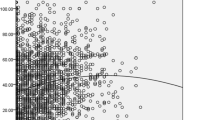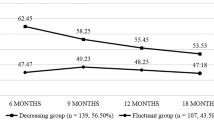Abstract
This cross-sectional study explored the prevalence of posttraumatic growth (PTG) and posttraumatic stress disorder (PTSD) in Tibetan adolescent survivors (98% Tibetan and 2% Han) 6 years after the 2010 Yushu earthquake to identify the PTG predictors. In 2016, 850 high school students (from 11 to 20 years) in Yushu (N = 850) completed the self-rating depression scale, the PTSD Check List-Civilian version, the exposure degree scale, and the posttraumatic growth inventory. It was found that the PTG and probable PTSD prevalence rates were 49.7% and 8.9% 6 years after the earthquake, and that exposure level, depression level, and PTSD symptoms were all significant negative predictors for PTG in both the junior high school and senior high school students. Specifically, having a lower degree of exposure, a lower PTSD level, and no depression symptoms were associated with higher PTG. There was a significant PTG difference found between males and females; however, this gender difference was not found in the senior high school students. No significant PTG differences were found for the different ethnicities. The implications of the results and the limitations of this study are discussed.
Similar content being viewed by others
References
Foa EB, Ehlers A, Clark DM, Tolin DF, Orsillo SM (1999) The posttraumatic cognitions inventory (ptci): development and validation. Psychol Assess 11:303–314
Wickrama T, Wickrama KAS, Banford A, Lambert J (2017) PTSD symptoms among tsunami exposed mothers in Sri Lanka: the role of disaster exposure, culturally specific coping strategies, and recovery efforts. Anxiety Stress Coping 30:415–427
Bokszczanin A (2008) Parental support, family conflict, and overprotectiveness: predicting PTSD symptom levels of adolescents 28 months after a natural disaster. Anxiety Stress Coping 21:325–335
Altindag A, Ozen S, Sir A (2005) One-year follow-up study of posttraumatic stress disorder among earthquake survivors in Turkey. Compre Psychiatry 46:328–333
Galea S, Resnick H, Ahern J, Gold J, Bucuvalas M, Kilpatrick D et al (2002) Posttraumatic stress disorder in manhattan, New York city, after the September 11th terrorist attacks. J Urban Health 79:340–353
Dai W, Chen L, Lai Z, Li Y, Wang J, Liu A (2016) The incidence of post-traumatic stress disorder among survivors after earthquakes: a systematic review and meta-analysis. BMC Psychiatry 16:188
Zhang Z, Wang W, Shi Z, Wang L, Zhang J (2012) Mental health problems among the survivors in the hard-hit areas of the Yushu earthquake. PLoS ONE 7:e46449
Liu DL, Hui C, Ling M, Wenqian B, Zailiang L, Changying C (2017) Post-traumatic stress disorder and its predictors among bereaved tibetan adolescents 4 years after the Yushu earthquake: a cross-sectional survey in china. J Clin Nurs 26(7–8):1095
Xiao ZL, Wen J, Zhao H, Tan QW, Lv X, Yan FB (2011) A bibliometric analysis on post-earthquake health issue related literature. Chin J Evid-Based Med 11:483–488
Calhoun LG, Tedeschi RG (2006) Handbook of posttraumatic growth: research & practice. Lawrence Erlbaum Associates Publishers, Mahwah, NJ
Tedeschi RG, Calhoun LG (1995) Trauma & transformation: growing in the aftermath of suffering. Psyccritiques 42(2):172
Tedeschi RG, Calhoun LG (2004) Posttraumatic growth: conceptual foundations and empirical evidence. Psychol Inq 15:1–18
Kilmer RP (2006) Resilience and posttraumatic growth in children. In Calhoun LG, Tedeschi RG (eds) Handbook of posttraumatic growth: research & practice. Lawrence Erlbaum Associates Publishers, Mahwah, NJ, pp 264–288
Tang CK (2007) Posttraumatic growth of Southeast Asian survivors with physical injuries: six months after the 2004 Southeast Asian earthquake-tsunami. Australasian Journal of Disaster and Trauma Studies. Retrieved from https://scholarbank.nus.edu.sg/handle/10635/22216
Hussain D, Bhushan B (2013) Posttraumatic growth experiences among Tibetan refugees: a qualitative investigation. Qual Res Psychol 10:204–216
Helgeson VS, Reynolds KA, Tomich PL (2006) A meta-analytic review of benefit finding and growth. J consult clin psych 74:797
Janoff-Bulman R (1992) Shattered assumptions. Free Press, New York
Joseph S, Linley PA (2004) Adversarial growth and positive change following trauma: theory, research, and practice. Ricerche Di Psicologia 27:177–190
Sawyer A, Ayers S, Field AP (2010) Posttraumatic growth and adjustment among individuals with cancer or hiv/aids: a meta-analysis. Clin Psychol Rev 30:436–447
Tang SK (2006) Positive and negative post-disaster psychological adjustment among adult survivors of the southeast asian earthquake-tsunami. J Psychosom Res 61:699–705
Mystakidou K, Tsilika E, Parpa E, Kyriakopoulos D, Malamos N, Damigos D (2008) Personal growth and psychological distress in advanced breast cancer. Breast 17:382–386
Alisic E, van der Schoot TAW, van Ginkel JR, Kleber RJ (2008) Looking beyond posttraumatic stress disorder in children: posttraumatic stress reactions, posttraumatic growth, and quality of life in a general population sample. J Clinl Psychiat 69:1455–1461
Hafstad GS, Gil-Rivas V, Kilmer RP, Raeder S (2010) Parental adjustment, family functioning, and posttraumatic growth among Norwegian children and adolescents following a natural disaster. Am J Orthopsychiat 80:248–257
Laufer A, Hamama-Raz Y, Levine SZ, Solomon Z (2009) Posttraumatic growth in adolescence: the role of religiosity, distress, and forgiveness. J Soc Clin Psychol 28:860–862
Kimhi S, Eshel Y, Zysberg L, Hantman S (2009) Postwar winners and losers in the long run: determinants of war relates stress symptoms and posttraumatic growth. Community Ment Health J 46:10–19
Milam JE, Ritt-Olsen A, Tan S, Unger JB, Nezami E (2005) The September 11th 2001 terrorist attacks and reports of posttraumatic growth among a multi-ethnic sample of adolescents. Traumatology 11:233–246
Vaughn AA, Roesch SC, Aldridge AA (2009) Stress-related growth in racial/ethnic minority adolescents: measurement structure and validity. Educ Psychol Meas 69:131–145
Kleim B, Ehlers A (2009) Evidence for a curvilinear relationship between posttraumatic growth and posttrauma depression and ptsd in assault survivors. J Traum Stress 22:45–52
Xu J, Liao Q (2011) Prevalence and predictors of posttraumatic growth among adult survivors one year following 2008 Sichuan earthquake. J Affect Disord 133:274
Koutrouli N, Anagnostopoulos F, Potamianos G (2012) Posttraumatic stress disorder and posttraumatic growth in breast cancer patients: a systematic review. Women Health 52:503–516
Meyerson DA, Grant KE, Carter JS, Kilmer RP (2011) Posttraumatic growth among children and adolescents: a systematic review. Clin Psychol Rev 31:949–964
Laufer A, Solomon Z (2006) Posttraumatic symptoms and posttraumatic growth among Israeli youth exposed to terror incidents. J Soc Clin Psychol 25:429–447
Xu J, Wei Y (2013) Social support as a moderator of the relationship between anxiety and depression: an empirical study with adult survivors of Wenchuan earthquake. PLoS ONE 8:e79045
State Council Information Office of China(SCIOC) (2010) Report of the progress of post-disaster relief after the Yushu earthquake (In Chinese). Retrieved from http://www.scio.gov.cn/ztk/xwfb/06/
Yu XN, Lau JT, Zhang J, Mak WW, Choi KC, Lui WW et al (2010) Posttraumatic growth and reduced suicidal ideation among adolescents at month 1 after the sichuan earthquake. J Affect Disord 123:327–331
Wu KK, Chan SK, Ma TM (2005) Posttraumatic stress, anxiety, and depression in survivors of severe acute respiratory syndrome (sars). J Traumat Stress 18:39–42
Li H, Wang L, Shi Z, Zhang Y, Wu K, Liu P (2010) Diagnostic utility of the ptsd checklist in detecting ptsd in chinese earthquake victims. Psychol Rep 107:733
Ruggiero KJ, Ben KD, Scotti JR, Rabalais AE (2003) Psychometric properties of the PTSD checklist—civilian version. J Traumat Stress 16:495–502
Jin Y, Li J (2015) Prospective study of posttraumatic stress in adolescents 6 and 24 months after the 2010 Yushu earthquake in China. J Nerv Ment Dis 203:679–683
Zung WW, Richards CB, Short MJ (1965) Self-rating depression scale in an outpatient clinic. Further validation of the sds. Arch Gen Psychiat 13:508
Wang RZ, Liu LF, Cui KY, Ge HM (2009) Study on the feasibility of the self-rating depression scale as a routine screened implement for depressive disorder of internal medicine inpatients. China J Health Psychol 17:923–925 (In Chinese)
Ge HM (2008) Study on the feasibility of the self-rating depression scale (SDS) as a conventional screened implement for depressive disorder of surgical inpatients (PhD dissertation). Shandong University, China
Triplett KN, Tedeschi RG, Cann A, Calhoun LG, Reeve CL (2012) Posttraumatic growth, meaning in life, and life satisfaction in response to trauma. Psychol Trauma 4:400–410
Arpawong TE, Richeimer SH, Weinstein F, Elghamrawy A, Milam JE (2013) Posttraumatic growth, quality of life, and treatment symptoms among cancer chemotherapy outpatients. Health Psychol 32:397–408
Zhou X, Wu X, Chen J (2015) Longitudinal linkages between posttraumatic stress disorder and posttraumatic growth in adolescent survivors following the Wenchuan earthquake in China: a three-wave, cross-lagged study. Psychiat Res 228:107–111
Flores EC, Carnero AM, Bayer AM (2014) Social capital and chronic post-traumatic stress disorder among survivors of the 2007 earthquake in Pisco, Peru. Soc Sci Med 101:9–17
Zhang LP, Zhao Q, Luo ZC, Lei YX, Wang Y, Wang PX (2015) Prevalence and risk factors of posttraumatic stress disorder among survivors five years after the “Wenchuan” earthquake in China. Health Qual Life Out 13:75
Wang R, Wang L, Li Z, Cao C, Shi Z, Zhang J (2013) Latent structure of posttraumatic stress disorder symptoms in an adolescent sample one month after an earthquake. J Adolesc 36:717
Elsass P, Phuntsok K (2009) Tibetans’ coping mechanisms following torture: an interview study of Tibetan torture survivors’ use of coping mechanisms and how these were verified by western counseling. Traumatology 15:3–10
Sachs E, Rosenfeld B, Lhewa D, Rasmussen A, Keller A (2008) Entering exile: trauma, mental health, and coping among Tibetan refugees arriving Daharmsala, India. J Traumat Stress 21:199–208
Levine SZ, Laufer A, Stein E, Hamama-Raz Y, Solomon Z (2009) Examining the relationship between resilience and posttraumatic growth. J Traumat Stress 22:282–286
Vishnevsky T, Cann A, Calhoun LG, Tedeschi RG, Demakis GJ (2010) Gender differences in self-reported posttraumatic growth: a meta-analysis. Psychol Women Q 34:110–120
Joseph S, Linley PA (2006) Growth following adversity: theoretical perspectives and implications for clinical practice. Clin Psychol Rev 26:1041–1053
Hankin BL, Abramson LY (2001) Development of gender differences in depression: an elaborated cognitive vulnerability-transactional stress theory. Psychol Bull 127:773–796
Nolen-Hoeksema S, Girgus JS (1994) The emergence of gender differences in depression during adolescence. Psychol Bull 115:424–443
Jin Y, Xu J, Liu D (2014) The relationship between post traumatic stress disorder and post traumatic growth: gender differences in PTG and PTSD subgroups. Soc Psychiatry Psychiatr Epidemol 49:1903–1910
Du B, Ma X, Ou X, Jin Y, Ren P, Li J (2018) The prevalence of posttraumatic stress in adolescents eight years after the Wenchuan earthquake. Psychiat Res 262:262–269
Cryder CH, Kilmer RP, Tedeschi RG, Calhoun LG (2006) An exploratory study of posttraumatic growth in children following a natural disaster. Am J Orthopsychiat 76:65–69
Miller J (2008) Parental cancer: the parent–child bond at risk. Diss Abstr Int B 69:2634
Author information
Authors and Affiliations
Corresponding author
Additional information
Publisher's Note
Springer Nature remains neutral with regard to jurisdictional claims in published maps and institutional affiliations.
Rights and permissions
About this article
Cite this article
Xie, Y., Wu, J. & Shen, G. Posttraumatic Growth in Tibetan Adolescent Survivors 6 Years After the 2010 Yushu Earthquake: Depression and PTSD as Predictors. Child Psychiatry Hum Dev 51, 94–103 (2020). https://doi.org/10.1007/s10578-019-00913-5
Published:
Issue Date:
DOI: https://doi.org/10.1007/s10578-019-00913-5




